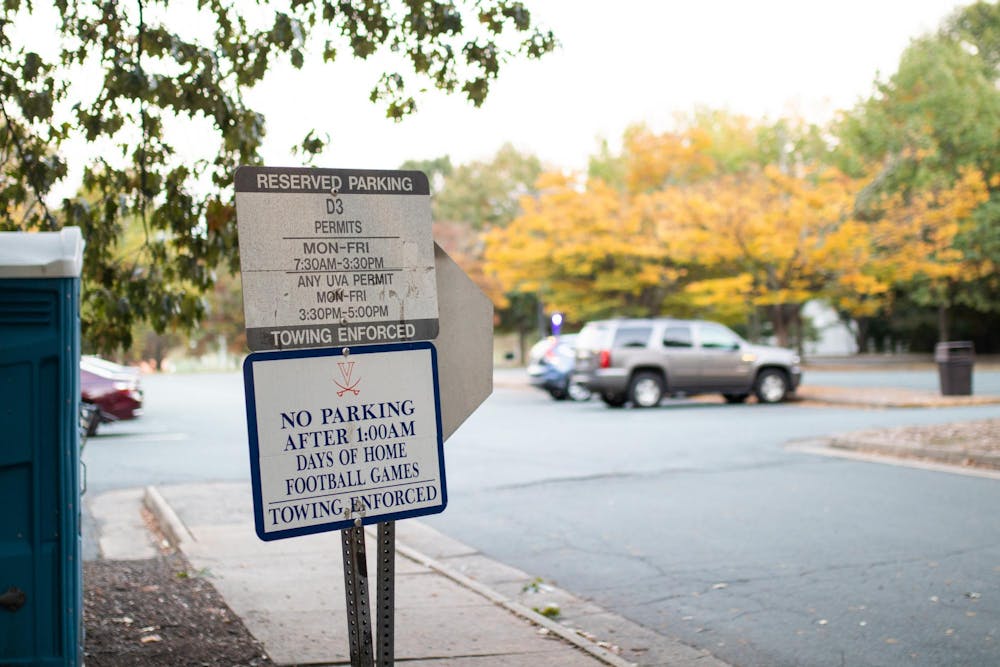Ask any student who has tried to deal with driving and its assorted tribulations on Grounds, and you are likely to get a thousand-yard stare. Cars are less of a luxury and more of a necessity for many students. They enable students to get groceries, work part-time jobs, visit home on short notice and overall have a degree of autonomy of movement. Despite this, parking spots are few and far between on Grounds, whether for an event, housing or gym usage. While it would be unwise to fix the issue by transforming the architectural splendor of the University into a series of towering parking garages, change is overdue. As it stands, the current parking system is convoluted, and the University must reinstitute affordability and accessibility.
At the University, parking comes in a couple of different forms. For visitors, event attendees and gymgoers, the ParkMobile app is used to pay for parking. At the gyms, parking is sparse, with a low proportion of available spots to daily gym attendees. For residential parking, students are hard-pressed to find spots on Grounds. First years are prohibited from bringing cars, except in extenuating circumstances. In all these cases, parking also tends to be pricey for students.
Consequently, first-year dorm buildings have very few, if any, parking spots. For upperclassmen, parking is not a guarantee, depending on their housing assignment. These factors combine to result in a parking system that alienates students who live on Grounds from their broader surroundings and limits students who live off Grounds from their access to key University facilities. All students, therefore, suffer in various ways from an inaccessible and unaffordable system which both limits their ability to obtain key needs such as food and work and also institutes excessive charges for those with cars.
The University’s new on-Grounds housing developments appear to do little to alleviate its dearth of available parking for students. Bond, Gaston and Ramazani have the lowest proportion of parking spots to residents. In addition, not all students wishing to reside on Grounds are guaranteed a parking spot, or even group access to one. Residents of Bice and Bond houses must enter a competitive lottery. If students acquire a parking pass, they have the luxury of paying around $720 annually, with the added caveat that permits are not renewable.
On its own, an insufficient number of parking spots for members of the student body residing on Grounds is a concern. However, the matter becomes even more pressing considering the University’s intention to house all second-year students on Grounds in the near future as part of its 2030 Plan. The University needs somewhere in the realm of 2,200 more beds to make this plan a reality, necessitating the development of more housing projects. Several thousand students means several hundred parking spots, a problem the University does not appear to have solved yet.
A 1,250-spot parking garage does currently exist on the Emmet-Ivy plot. However, this garage is routinely packed to the brim with faculty and students from the School of Architecture, School of Law and assorted visitors to John Paul Jones Arena. This is to say nothing of the soon-to-be-constructed Virginia Guesthouse’s short-term residents, who will be staying in one of the building’s 217 rooms. Provisions were made for a temporary parking area on the site of the old University Gardens apartment complex, but preliminary documents make no mention of a permanent parking solution. This is an aspect of University-provided housing that should be non-negotiable, given the lack of a choice presented to students.
It is paramount that parking, both pre-existing and to be constructed, is made affordable. There are a number of ways to rectify this parking shortage. For the Emmet-Ivy housing, the University could go vertical, adding floors to the already planned parking garage, or additional parking near the other new development across Emmet Street. The aforementioned temporary parking at University Gardens could be expanded to permanent parking, and, if necessary, another parking garage constructed. Parking garages may not be a shining example of architectural splendor in line with Jefferson’s original views, but if the University is going to continue with its mandate of on-Grounds living for second years, they should take the needs of the student into consideration, as opposed to those of their contractors. Doing otherwise would severely restrict the independence of students, placing them at the mercy of the University and City public transit systems.
For better or worse, a substantial number of students bring their cars to school every year. The University can either choose to ignore this fact, or they can accommodate their students. While the University can force students to remain on Grounds and refuse to give them adequate access to parking, doing so is a bad idea. It would do little to win the favor of students, both current and prospective. The University has a responsibility to do right by those students, and allocating a reasonable number of parking spots for students is only fair.
Conall Castagno is an opinion columnist who writes about politics for The Cavalier Daily. He can be reached at opinion@cavalierdaily.com.
The opinions expressed in this column are not necessarily those of The Cavalier Daily. Columns represent the views of the author alone.







